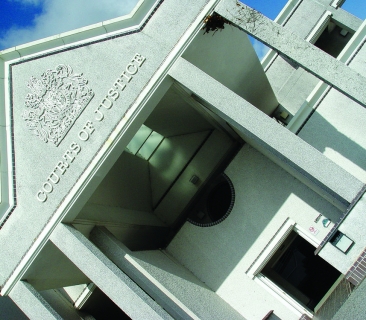Architecture
Truro is home to what has been described as "the finest examples of Georgian architecture west of Bath". This, mixed in with the city's glorious Gothic-style cathedral, the iconic Courts of Justice building and modern office blocks along Malpas Road make Truro's architectural scene both eclectic and spectacular.
Landmark buildings
Truro Cathedral: Truro Cathedral stands at the heart of Cornwall's main retail and administrative centre; the focal point of the city. A glorious building, its three magnificent spires soar heavenwards dominating the city's skyline. Truro Cathedral is relatively young at 125 years old. The foundation stone was laid by the then Duke of Cornwall, and future Edward VII, on 20th May 1880. It was the first new Anglican Cathedral to be built in this country for well over 600 years since Salisbury had been begun in 1220.
Assembly Rooms: An attractive building at High Cross which was once Truro's centre for elegant entertainment. It was built in life 1787, Wedgewood plaques on the building's facade show playwrights Shakespeare, Garrick and Thalia.
Crown Courts: Designed by architects Evans & Shalev, the people behind the Tate St Ives, Truro's Crown Courts are based at the top of Edward Street on the site of an original 12th century, Norman castle.
Town Hall: The hall was designed by Christopher Eales and built in 1846. It houses the Municipal Buildings, where Truro City Council sits, as well as the Hall for Cornwall and the Tourist Information Centre.
Coinage Hall: The current building was built as the Cornish Bank in 1848 on the site of the old Coinage Hall where twice yearly tin was brought here to be assayed and taxed.
Walsingham Place: Take time to wander through the peaceful Walsingham Place off Victoria Square, a spot much loved by the poet laureate John Betjeman. The architect of this beautiful Georgian terrace is thought to be Philip Sambell.
Lemon Street: With its attractive Georgian architecture, Lemon Street was built to provide easy access into Truro for the Quiksilver mail coaches from Falmouth.
Truro Cathedral: Truro Cathedral stands at the heart of Cornwall's main retail and administrative centre; the focal point of the city. A glorious building, its three magnificent spires soar heavenwards dominating the city's skyline. Truro Cathedral is relatively young at 125 years old. The foundation stone was laid by the then Duke of Cornwall, and future Edward VII, on 20th May 1880. It was the first new Anglican Cathedral to be built in this country for well over 600 years since Salisbury had been begun in 1220.
Assembly Rooms: An attractive building at High Cross which was once Truro's centre for elegant entertainment. It was built in life 1787, Wedgewood plaques on the building's facade show playwrights Shakespeare, Garrick and Thalia.
Crown Courts: Designed by architects Evans & Shalev, the people behind the Tate St Ives, Truro's Crown Courts are based at the top of Edward Street on the site of an original 12th century, Norman castle.
Town Hall: The hall was designed by Christopher Eales and built in 1846. It houses the Municipal Buildings, where Truro City Council sits, as well as the Hall for Cornwall and the Tourist Information Centre.
Coinage Hall: The current building was built as the Cornish Bank in 1848 on the site of the old Coinage Hall where twice yearly tin was brought here to be assayed and taxed.
Walsingham Place: Take time to wander through the peaceful Walsingham Place off Victoria Square, a spot much loved by the poet laureate John Betjeman. The architect of this beautiful Georgian terrace is thought to be Philip Sambell.
Lemon Street: With its attractive Georgian architecture, Lemon Street was built to provide easy access into Truro for the Quiksilver mail coaches from Falmouth.
Quality sites
- Non Gamstop Casinos
- Casinos Not On Gamstop
- Non Gamstop Casinos
- Non Gamstop Casino
- UK Online Casinos Not On Gamstop
- Non Gamstop Casinos UK
- Slots Not On Gamstop
- Non Gamstop Casino UK
- Casinos Not On Gamstop
- Casinos Not On Gamstop
- Best Casinos Not On Gamstop
- Non Gamstop Casinos
- Betting Site
- Non Gamstop Casinos
- Non Gamstop Casinos
- Slots Not On Gamstop
- UK Online Casinos Not On Gamstop
- UK Casinos Not On Gamstop
- Casinos Not On Gamstop
- Casinos Not On Gamstop
- New Casinos Not Blocked By Gamstop
